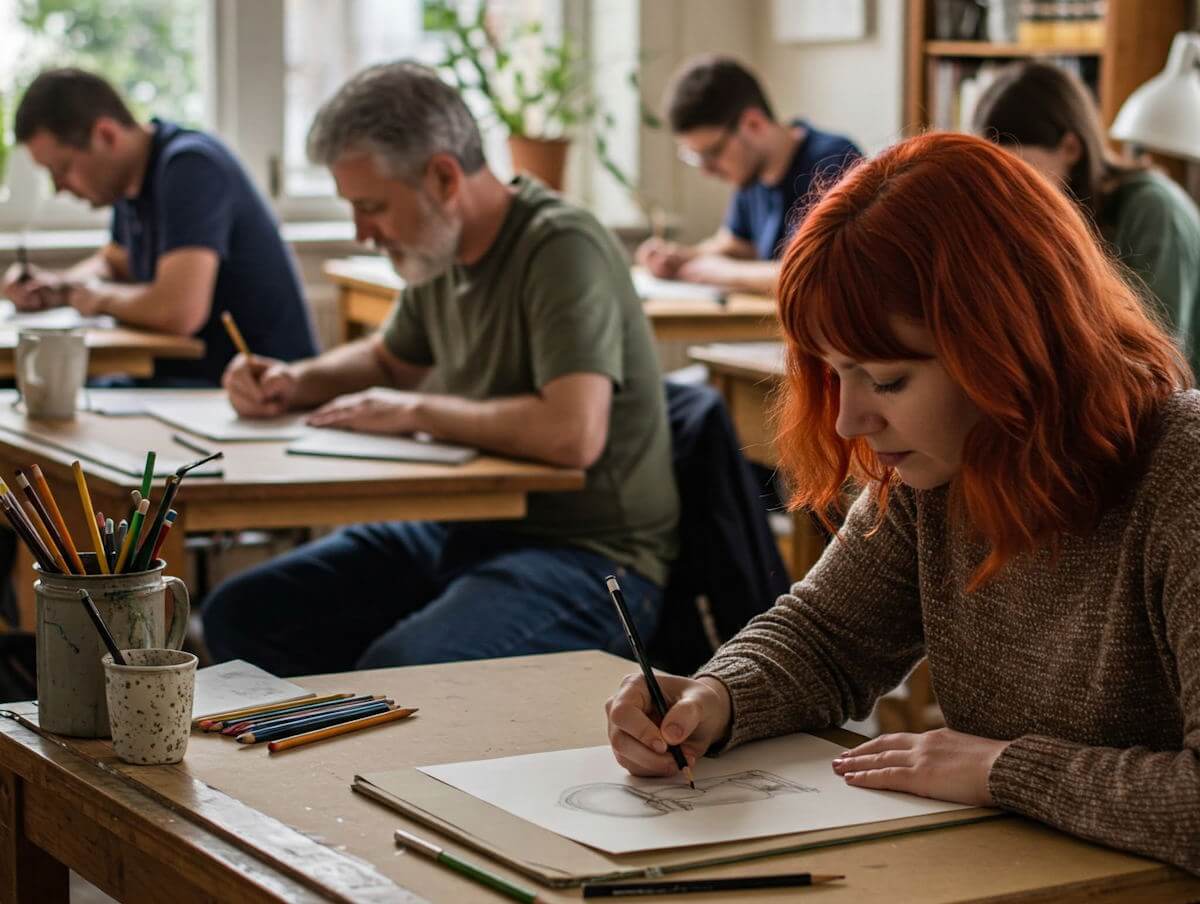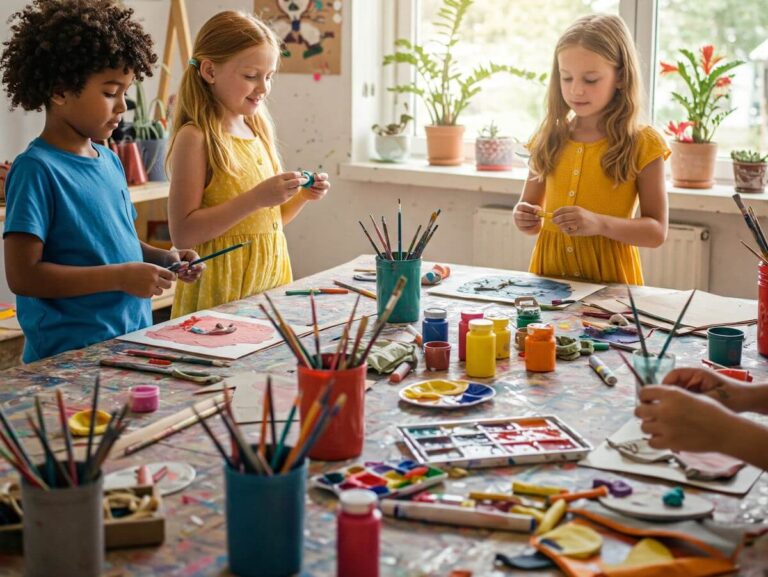Introduction to Venue Selection
Choosing the right venue for your art class is a fundamental aspect that significantly influences the overall experience for both the instructor and students. The selection of an appropriate space can enhance creativity, facilitate learning, and foster a supportive environment. A well-chosen venue offers more than just a physical location; it embodies an ambiance that resonates with artistic expression and encourages participants to engage actively during every session.
Accessibility is one of the primary factors to consider when selecting a venue. It is essential that the location is easily reachable for all participants, which may include considerations for public transportation options, parking availability, and wheelchair accessibility. If a venue is difficult to access, it may deter potential students from attending, thus negatively impacting enrollment and the overall success of the class. Hence, prioritizing accessibility can enhance overall participation and engagement levels in the art class.
Furthermore, the ambiance of the venue plays a crucial role in the participants’ experience. An inspiring and visually appealing environment can spark creativity and motivate students to explore their art. For instance, natural lighting and adequate wall space for displaying work can create an uplifting atmosphere conducive to artistic pursuits. Additionally, the size of the venue must be suitable for the group dynamics. A space that is too cramped may hinder movement and limit interaction, while an excessively large venue might make the experience feel impersonal.
In summary, the importance of selecting the perfect venue for your art class cannot be overstated. The right space will not only enhance comfort and accessibility but will also contribute to the overall creative experience. Thus, careful consideration of factors such as accessibility, ambiance, and size is vital in creating a successful art education experience for all involved.
Understanding Your Needs
When selecting a venue for your art class, it is crucial to assess your specific requirements thoroughly. Every art class can differ significantly based on various factors such as the number of students, the type of art being taught, and the facilities required to ensure a conducive learning environment.
Firstly, consider the number of students you anticipate enrolling in your art class. This number will directly influence the size and layout of the venue. A smaller class may thrive in an intimate setting that fosters close interaction and individual guidance, while a larger group may necessitate a more spacious area with adequate room for each participant to work comfortably without hindrance. It is advisable to choose a venue that not only accommodates your expected class size but also allows for potential growth in enrollment.
Secondly, the type of art being taught is a vital factor in determining your venue’s suitability. Different art forms may require various setups and resources. For instance, a painting class may need access to natural light and surfaces that can be easily cleaned, while a sculpture workshop might demand extensive space, tools, and storage for materials. Ensuring that the venue possesses the specific facilities and equipment necessary for your particular discipline will greatly enhance the effectiveness of your teaching.
Additionally, consider logistical factors such as accessibility and location. The venue should be easily reachable by your target audience, as this can influence student attendance and overall interest in joining your course. Furthermore, assess the availability of essential utilities, such as restrooms, ventilation, and parking, which can significantly enrich the experience for both instructors and students.
By systematically evaluating these factors—student numbers, the type of art, and essential facilities—you will be better equipped to choose a venue that aligns with your goals as an art instructor. This comprehensive understanding is a pivotal step in ensuring a successful art class experience.
Location Considerations
Choosing the right location for your art class is a crucial aspect that can significantly influence student attendance and their overall enjoyment of the experience. One of the primary factors to consider in this decision is the proximity to public transportation. A venue that is easily accessible via buses and trains will attract more participants, particularly for those who do not have access to private transportation. The convenience of reaching the venue can often be the deciding factor for potential students when selecting art classes.
In addition to public transport options, parking availability plays a vital role in the selection process. If the venue offers ample parking space, it eases the burden for those who drive to the class. Limited parking can deter students from attending, causing frustration and reducing overall class size. It is beneficial to explore venues that provide dedicated parking facilities or consider those located in areas with street parking that are convenient and safe.
Neighborhood safety is another essential consideration when evaluating venue options. A secure and welcoming environment contributes to a positive learning atmosphere and is particularly important for attracting parents who may be enrolling their children in art classes. Areas that are known for their safety and community engagement can create a sense of comfort for potential students, encouraging them to join the class. Furthermore, neighborhoods that feature vibrant art scenes not only match the class’s theme but can also entice individuals interested in the arts.
Ultimately, the ideal location will integrate accessibility, parking, and safety to create a conducive environment for creativity and learning. By prioritizing these factors, instructors can enhance the overall experience for their students, ensuring that their art classes thrive both in attendance and participation.
Ambiance and Environment
The ambiance and environment of a venue play a critical role in nurturing creativity for art classes. An ideal space should not only accommodate the practical needs of an art session but also inspire and engage the participants. Factors such as light, color, and overall spatial dynamics contribute substantially to the creative process, allowing individuals to express themselves freely and fully.
Natural light is often regarded as one of the most important elements of an art class venue. Well-lit spaces enhance visibility and reduce strain on the eyes, providing an inviting atmosphere where artists can comfortably work on their projects. Large windows that allow daylight to flood in create a vibrant environment, motivating students and instructors alike. On the other hand, soft, artificial lighting can be utilized in spaces designed for evening classes, offering a cozy ambiance conducive to artistic exploration.
Color is another essential attribute to consider when choosing a venue for art classes. Different colors evoke various emotional responses and can significantly impact the mood of the participants. For instance, warmer tones such as yellows and oranges can foster a feeling of warmth and energy, while cool colors like blues and greens may instill calmness and focus. Therefore, selecting a space that incorporates a harmonious color palette can greatly enhance the creative output of those involved.
The layout and space available in an art class setting also affects how participants interact with each other and their materials. An open floor plan with ample room for movement encourages collaboration and interaction, while smaller, more defined spaces can foster intimacy and deeper focus. Depending on the nature of the class, an unconventional venue such as an art studio, gallery, or even an outdoor setting can provide a refreshing change from traditional classrooms, stimulating creativity and making the learning experience memorable.
Accessibility and Inclusivity
When organizing an art class, selecting a venue that emphasizes accessibility and inclusivity is paramount. A well-chosen location not only facilitates participation but also fosters an environment where all students can thrive, regardless of their physical capabilities. It is essential to evaluate the venue for key features that accommodate individuals with disabilities and ensure that everyone has the opportunity to engage with the artistic curriculum.
One of the foremost considerations in accessibility is the presence of ramps and elevators. Venues should have smooth, wide access points that enable individuals using wheelchairs or mobility aids to enter without obstruction. Elevators must be adequately sized and equipped with controls that are easily reachable for individuals of varying heights and abilities. Additionally, checking the floor surface is vital as it should be stable and free from any trip hazards that could impede movement.
Restroom facilities should also reflect inclusivity. Accessible restrooms ought to be spacious enough to accommodate individuals with mobility aids, allowing for ease of use. Moreover, they should be equipped with handrails and appropriate signage to guide all students effectively. Ensuring that such facilities are well-maintained is crucial to providing a comfortable experience for every participant.
Furthermore, it may be beneficial to consider the proximity of public transportation options and parking accommodations. A venue conveniently located near accessible transit will be more appealing to students who rely on these services. Additionally, providing designated parking spots for individuals with disabilities will enhance ease of access and encourage participation from all students.
Budgeting for the Venue
When planning an art class, one of the most important aspects to consider is budgeting for the venue. This involves evaluating various cost factors that contribute to the overall expenditure. Rental costs typically form the cornerstone of this budget. Understanding the pricing structure of potential venues is essential. Rates can vary significantly based on the location, the size of the space, and the amenities offered. It is advisable to compile a list of venues you are interested in and request detailed quotes, which will aid in making a well-informed decision.
In addition to rental costs, instructors must also take into account insurance requirements. Many venues require proof of liability insurance, which can incur additional expenses. Shopping around for competitive insurance options can mitigate costs and ensure compliance with venue policies. It is prudent to determine what level of coverage is necessary for a safe and professional environment.
Utilities are another key component of the venue budget. Some venues may include utility costs in their rental fee, while others may charge separately for water, electricity, or heating and cooling systems. Instructors should clarify these details upfront to prevent unanticipated financial burdens. Furthermore, it is necessary to consider potential hidden fees that could arise, such as cleaning charges or security deposits, which can also significantly influence the total cost.
By understanding these factors and evaluating them judiciously, art class instructors can develop a comprehensive budget that aligns with their financial constraints while ensuring that they secure an appropriate space for their classes. Careful budgeting for the venue not only enhances the learning experience but also contributes to the overall success of the art class initiative.
Inspecting Potential Venues
When evaluating potential venues for your art class, careful inspection is essential to ensure that the space meets your requirements. Begin by examining the overall layout of the venue. Look for a space that can comfortably accommodate your expected number of participants while allowing for movement and interaction. A well-organized layout can facilitate a creative environment, encouraging students to engage with their art tasks without feeling cramped.
Next, consider the availability and condition of necessary equipment. Assess whether the venue has the required supplies such as easels, tables, and storage areas for art materials. Pay attention to the quality of the equipment; worn-out or damaged items can hinder the learning experience. Additionally, it’s beneficial to inquire about the accessibility of tools needed for specific techniques, such as pottery wheels for clay classes or ovens for baking clay projects.
Overall upkeep of the venue is another important aspect to evaluate. A clean and well-maintained environment not only reflects professionalism but also contributes positively to the learning atmosphere. Look for signs of regular maintenance, such as clean restrooms, dust-free surfaces, and functional lighting. A space that is neglected may convey a lack of respect for the craft and could affect participants’ motivation.
Furthermore, consider the location of the venue. Ensure it is easily accessible for your students, as convenience can greatly impact attendance. Take note of available parking or public transportation options nearby. Safety is also vital, so check for secure entrances and adequate lighting around the venue premises.
By following this checklist during venue visits, you can confidently select a space that supports the artistic development of your students and fosters an inspiring learning environment.
Feedback and Input from Previous Class Holders
Choosing the right venue for your art class is crucial for creating an inspiring and productive environment. To make an informed decision, seeking feedback from individuals who have previously held classes in the venue can provide valuable insights. Their personal experiences can illuminate aspects that may not be immediately apparent during a venue tour or initial inquiry. One effective approach is to reach out to former class holders and ask a series of targeted questions that cover various elements of their experience.
Firstly, inquire about the atmosphere of the venue. Potential questions could include: “Did you find the space conducive to creativity?” or “How did the layout support your teaching style?” The answers to these questions will help gauge whether the ambiance aligns with your class objectives and whether it encourages artistic expression. Additionally, consider asking about the resources available on-site. For instance, ask: “Were the necessary art supplies and tools readily available?” This inquiry can save you from overlooking critical resources that might enhance the learning experience.
Another vital aspect to explore is logistical concerns. Questions such as “How was the parking situation for your students?” or “Did you encounter any challenges with accessibility?” will offer insights into the practicalities of class attendance. Moreover, understanding the strengths and weaknesses of the venue from others who have utilized it can assist you in evaluating its overall suitability for your specific needs.
Finally, do not hesitate to ask about the level of support provided by the venue staff. Knowing that you have reliable assistance can significantly affect the smooth running of your classes. Gathering this qualitative data from previous class holders can serve as a vital resource in making a well-rounded decision, ultimately enhancing the educational journey for your students.
Finalizing Your Venue Choice
As you approach the final stages of your venue selection for an art class, it is imperative to meticulously review the information you have gathered throughout the decision-making process. A thorough assessment of each potential venue’s attributes, limitations, costs, and accessibility can aid significantly in narrowing down your options. Key factors such as size, lighting, location, and available facilities should be revisited and evaluated against your class requirements and target audience.
Additionally, consider the overall vibe of each venue. The atmosphere can greatly influence the creativity and engagement levels of participants. It is advisable to visualize how the chosen space aligns with the atmosphere you wish to create, whether that be an inspiring outdoor setting, a cozy indoor studio, or a vibrant community center. This thought process not only aids in finding a suitable venue but also ensures that it resonates well with your artistic vision.
Another critical aspect to keep in mind is the necessity for a contingency plan. Even the best-laid plans can encounter unexpected challenges such as double bookings, maintenance issues, or adverse weather conditions impacting the chosen venue. Preparing alternative options ensures that your art class can proceed smoothly, irrespective of unforeseen circumstances. This could involve identifying backup venues or being ready to shift to an online format if necessary. By having a well-thought-out contingency plan, you can elevate your organizational efforts and demonstrate professionalism to your participants.
In conclusion, finalizing your venue choice is a pivotal phase in organizing an art class. By thoroughly evaluating your gathered information and preparing for potential challenges, you can ensure a rewarding experience for both yourself and your students, thus fostering an environment conducive to artistic exploration and growth.




